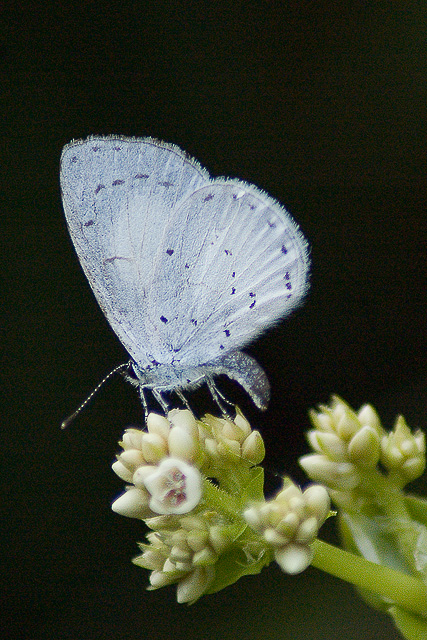- Akasinula akasa
Taxobox
name = White Hedge Blue

image_width = 180px
image_caption = White Hedge Blue
regnum =Animal ia
phylum =Arthropod a
classis =Insect a
ordo =Lepidoptera
superfamilia =Papilionoidea
familia =Lycaenidae
genus = "Akasinula "
species = "A. akasa"
binomial = "Akasinula akasa"
binomial_authority = (Horsfield, 1828)
synonyms = "Cyaniris akasa" "Lycaenopsis akasa"The White Hedge Blue ("Akasinula akasa") [http://internt.nhm.ac.uk/jdsml/research-curation/projects/lepindex/detail.dsml?TaxonNo=201506.0&UserID=&UserName=&&listPageURL=list%2edsml%3fSCIENTIFIC%5fNAME%5fon%5fcardqtype%3dstarts%2bwith%26sort%3dSCIENTIFIC%255fNAME%255fon%255fcard%26SCIENTIFIC%5fNAME%5fon%5fcard%3dakasa%26recLimit%3d30&searchPageURL=index%2edsml%3fsort%3dSCIENTIFIC%255fNAME%255fon%255fcard%26SCIENTIFIC%5fNAME%5fon%5fcardqtype%3dstarts%2bwith%26SCIENTIFIC%5fNAME%5fon%5fcard%3dakasa%26recLimit%3d30 Card for species "akasa" in LepIndex. Accessed 14 October 2006.] ] is a small
butterfly found inIndia Evans,W.H.(1932) The Identification of Indian Butterflies, ser no H21.14, pp 221-226] that belongs to the Lycaenids or Blues family.Taxonomy
The butterfly was earlier known as "
Lycaenopsis akasa " (Fruhstorfer).Description
Male Upperside, fore wing: black; a medial triangular area that extends from base outwards to the disc white, suffused at base and anteriorly with iridescent blue that spreads upwards on to the black of the costa; along the dorsum the black groundcolour is much paler, in most specimens diffuse fuscous. Hind wing: white, basal third and costal margin broadly suffused with fuscous, the fuscous at base posteriorly overlaid with iridescent blue; a subterminal series of fuscous-black dots and a distinct but very slender black anticiliary line. Underside : white very slightly tinged with bluish; markings all fuscous black, minute and very slender. Fore wing: a short disco-cellular line followed by on anteriorly, strongly curved, discal series of very short detached lines and a more or less obsolescent transverse series of subterminal dots. Hind wing: three subbasal dots in transverse order; a short line on the discocellulars; a spot below the middle of the costa with a smaller spot below it; a posterior discal irregular sinuous series of five or six minute spots and a perfectly regular subterminal series of similar spots. Cilia of both fore and hind wings white. Antennae, head, thorax and abdomen blackish, the antennae ringed with white ; beneath : the palpi, thorax and abdomen snow-white.
Female: Very similar. Upperside: the white area much more extended on both fore and hind wings. On the former it spreads well into the cell, on the latter three-fourths of the wing are white; the dusky basal and costal areas much more restricted than in the male. The iridescent blue suffusion is in many specimens entirely absent, in a few very faintly indicated ; the subterminal series of black dots so distinct in the male are generally faint and obsolescent. Underside: as in the male but the markings less distinct. Antennae, head, thorax and abdomen as in the male. [Bingham, C. T. (1907) Fauna of British India. Butterflies. Volume 2.]
Range
It is found in
Sri Lanka andSouth India .Cited references
ee also
*
List of butterflies of India (Lycaenidae) References
* Beccaloni, G. W., Scoble, M. J., Robinson, G. S. & Pitkin, B. (Editors). 2003. The Global Lepidoptera Names Index (LepIndex). World Wide Web electronic publication. http://www.nhm.ac.uk/entomology/lepindex [accessed 14 October 2006] .
* Evans, W.H. (1932) The Identification of Indian Butterflies. (2nd Ed), Bombay Natural History Society, Mumbai, India
Wikimedia Foundation. 2010.
